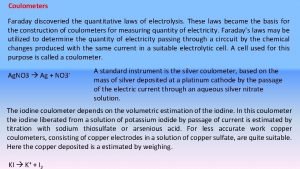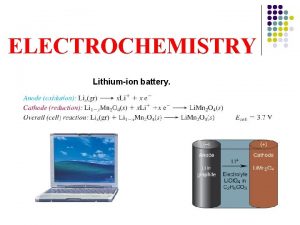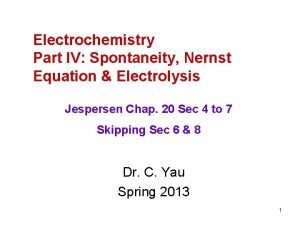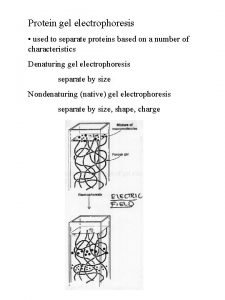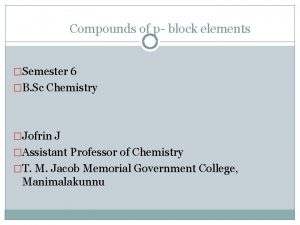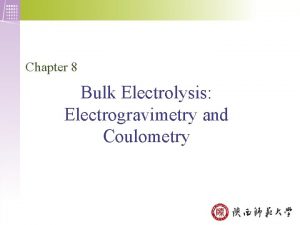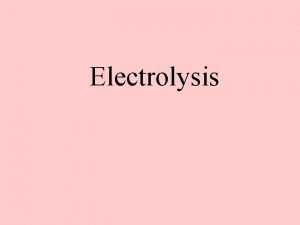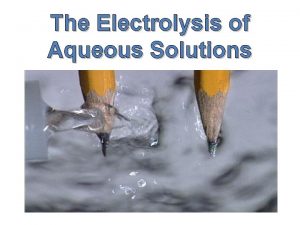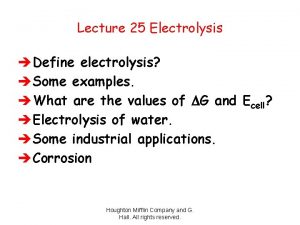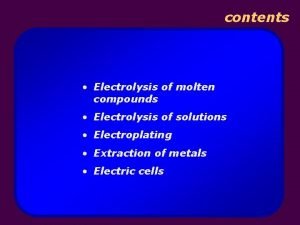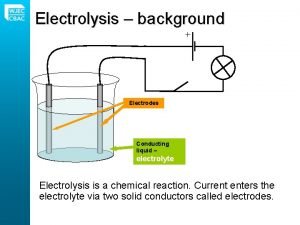Coulometers Faraday discoveried the quantitative laws of electrolysis










- Slides: 10

Coulometers Faraday discoveried the quantitative laws of electrolysis. These laws became the basis for the construction of coulometers for measuring quantity of electricity. Faraday’s laws may be utilized to determine the quantity of electricity passing through a circcuit by the chemical changes produced with the same current in a suitable electrolytic cell. A cell used for this purpose is called a coulometer. Ag. NO 3 Ag + NO 3 - A standard instrument is the silver coulometer, based on the mass of silver deposited at a platinum cathode by the passage of the electric current through an aqueous silver nitrate solution. The iodine coulometer depends on the volumetric estimation of the iodine. In this coulometer the iodine liberated from a solution of potassium iodide by passage of current is estimated by titration with sodium thiosulfate or arsenious acid. For less accurate work copper coulometers, consisting of copper electrodes in a solution of copper sulfate, are quite suitable. Here the copper deposited is a estimated by weighing. KI K+ + I 2

Faraday’s studies revealed the relationship between amounts of electricity transferred through solutions and the amounts of chemical change observed during electrolysis. The amount of substance formed or consumed during electrolysis is proportional to the amount of electric charge passed through the electrolyte. When equal amounts of electric charge are passed through electrolytes the amounts of different substances formed or consumed on the electrode are proportional to their equivalent weights. These two laws can be expressed more concisely by the following equation

When equal amounts of electric charge are passed through electrolytes the amounts of different substances formed or consumed on the electrode are proportional to their equivalent weights. İn which m is the mass of a substance (an element, in the simplest cases) deposited on or removed from an electrode, M is the atomic weight of an element and z is the magnitude of the charge on its ions in terms of the electronic charge as a unit, I is the elecric current in ampheres, t is the time in seconds, and F is a constant which is called the FARADAY. 1 FARADAY is the amount of charge that is transferred when 1 mole of substance, containing Avogadro’s numbers of atoms, is deposited or removed. F = 1. 6021 x 10 -19 x 6. 0225 x 1023 = 96500 coulomb/equivalent

SIGNIFICANCE OF FARADAY’S LAWS • Milikan and the others have established that the charge on the electron is equal to 1. 602 x 10 -19 coulomb of electricity. Consequently the number of electrons in Faraday is • 96, 496 / 1. 602 x 10 -19 = 6. 023 x 1023 electrons • But, 6. 023 x 1023 is exactly Avogadro’s number. Hence, we must conclude that 1 Faraday of electricity is associated with 6. 023 x 1023 particles of unit charge, or, in general with one equivalent of a chemical substance. When 1 Faraday of electricity is passed through a solution, Avogadro’s number of electrons is removed from the cathode by reduction of one equivalent of substance, and exactly the same number of elecctrons is donated to the anode as a result of oxidation.

Conductivity measurements Typical conductivity cells are also shown in Fig. 15. 1. Instead of measuring their dimensions, we now usually calibrate these cells before use with a solution of known conductivity, such as normal potassium chloride. The cell must be well thermostated since the conductivity increases with the temperature. Solutions of electrolytes follow Ohm's Law. The resistance was independent of the emf, and the smallest applied voltage sufficed to produce a current of electricity. Any conductivity theory would have to explain this fact: the electrolyte is always ready to conduct electricity and this capability is not something produced or influenced by the applied emf.

Electrolytic Conductivity (Equivalent conductivity) The conductivity of electolyte solutions differs from metallic conductivity. Most familiar is the conduction of electricity through metallic wires, in which case the mobile, charged entities are electrons. Electrolytic conductivity always involves both the transport of matter and chemical changes at the electrodes that electric current enters and leaves the electrolyte. These phenomena is not observed with metallic conductivity. Electric current can produce chemical reactions, an conversely, chemical reactions can produce electric current, The reistance of an electrolytic conductor to current passage can be determined by the application of Ohm’s law to such conductors. As is well known, the resistance of any conductor is proportional directly to it lengh and inversely to its cross-sectional area, namely,

A more accurate method, however, involves an indirect determination of the cell constant for a particular conductance cell by measurement of the resistance of the cell when it is filled with a 25 C. solution of KCl at known concentration and temperature. The cell constant is then found from a tabulated value of the conductivity of the KCl solution which has been accurately determined as a function of the concentration. For example, a conductance cell is found to have a resistance of 35. 42 ohms when it is filled with 0. 1 M KCl at. The conductivity of this solution is 0. 01288 ohm-1 cm-1. Consequently the value of the cell constant is 35. 42 ohms x 0. 01288 ohm-1 cm-1 = 0. 4562 cm-1. The equivalent conductance of an electrolyte is defined as the conductance of a volume of solution containing one equivalent weight of dissolved substance when placed between to parallel electrodes 1 cm apart. ( ) is never determined directly, but is calculate from the specific conductance if (C) is the concentration of a solution in gram equivalents per liter, then the concentration per cubic centimeter is C/1000 and the volume containing one equivalent of the solute is, and hence ( ) will be The conductivity of a particular electrolytic solution depend not only on the nature of the solute but also on its concentration. To take the concentration into consideration, Kohlrausch, who was a pioneer in the precise measurement of electrolytic conductance, defined the equivalent conductivity ( ) in this way : = 1000 / C C is the concentration of the solution in equivalent per liter and the units of A are cm 2 ohm-1 equiv-1.

The equivalent conductivity is equal to the conductance of enough solution to contain 1 equivalent when this solution is placed between paralel elecrodes of sufficiently large are placed 1 cm apart. Figure 16. 3. equivalent conductivity as a function of for a strong and weak electrolyte Kohlraush found empirically from measurements made on a large of number of aqueous solutions that for many electrolytes, of which KCl is a typical example, the equivalent conductivity is a nearly linear function of the square root of the concentration. This function, which fits the data most closely at low concentration (Fİg 16 -3), can be represented by the equation

in which is a constant and o is the limiting value of the equivalent conductivity extrapolated to infinite dilution (C = 0). Electrolytes as KCl are called strong. For other electrolytes, such as acetic acid, the value of increases greatly at low concentrations. Such electrolytes are called weak. It can be seen that reliable values of o can be obtained for strong electrolytes, but not for weak electrolytes. Values of o are critically depend on the reliability of the measurements made on solutions whose concentrations are low. In this concentration range, the conductance due to the ions from the water or other solvent may be a significant fraction of the total conductance. . When Kohlrausch had obtained the limiting equivalent conductivities at infinİte dilution for a number of strong electrolytes, ıt was found empirically that these values could be expressed as sums of limiting ionic conductivities, o+ and o- each of which is independent of the nature of the other ion; thus

this fact implies that the positive and negative ions move independently of each other when an electric current is passed through an electrolytic solution of very low concentrations. This statement is called Kohlrausch’s law of independent migration of ions. Since the o values for a given ion depend only on the solvent and the temperature.
